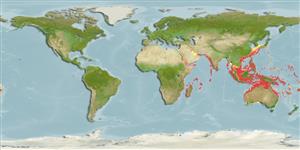Environment: milieu / climate zone / depth range / distribution range
Ecologia
marinhas demersal; intervalo de profundidade 18 - 141 m (Ref. 4900). Tropical
Indo-West Pacific: Persian Gulf and Red Sea, through the northern Indian Ocean to the South China Sea, north to southern Japan and south to the Indo-Australian Archipelago and New Caledonia. Report from Madagascar needs confirmation.
Tamanho / Peso / Idade
Maturity: Lm ? range ? - ? cm
Max length : 13.0 cm TL macho/indeterminado; (Ref. 9824)
Raios dorsais (total) : 83 - 98; Raios anais : 65 - 77; Vértebras: 41 - 42. Body with a large dark spot posteriorly on the base of both the dorsal and anal fins and with elongated anterior rays in the dorsal fin.
Inhabits sand, mud, and gravel bottoms (Ref. 9824). Feeds on benthic animals (Ref. 8924).
Ciclo de vida ou comportamento de acasalamento
Maturidade | Reprodução | Desova | Ovos | Fecundidade | Larvas
Amaoka, K., O. Okamura and T. Yoshino, 1992. First records of two bothid flounders, Grammatobothus polyophthalmus and Arnoglossus tapeinosoma, from Japan. Jap. J. Ichthyol. 39(3):259-264. (Ref. 9203)
Status na Lista Vermelha da UICN (Ref. 130435: Version 2024-1)
Ameaça para os humanos
Harmless
Uso pelos humanos
Pescarias: pouco comercial
Ferramentas
Relatórios especiais
Baixar XML
Fontes da internet
Estimates based on models
Preferred temperature (Ref.
123201): 23.3 - 28.3, mean 27.1 °C (based on 792 cells).
Índice de diversidade filogenética (Ref.
82804): PD
50 = 0.5000 [Uniqueness, from 0.5 = low to 2.0 = high].
Bayesian length-weight: a=0.00912 (0.00408 - 0.02036), b=3.04 (2.85 - 3.23), in cm total length, based on LWR estimates for this (Sub)family-body shape (Ref.
93245).
Nível Trófico (Ref.
69278): 3.5 ±0.37 se; based on food items.
Resiliência (Ref.
120179): médio(a), tempo mínimo de duplicação da população 1,4 - 4,4 anos (Preliminary K or Fecundity.).
Fishing Vulnerability (Ref.
59153): Low vulnerability (10 of 100).
